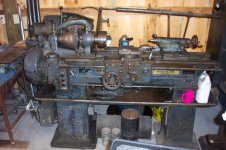I had seen the Lincoln Miller, but not the Globe, which takes the concept much further.
I did something a bit like this years ago on a 3-axis machining center:
Mounted the lathe tools to the table, in a line, like on a swiss machine
Chucked the short bar work in # 40 collet holders in the tool magazine
Used the machining center tool changer as a robot loader
Used the milling spindle as a lathe
The ATC was faster than a robot load
And the rapid time from one lathe tool to the next was faster than any turret index
But limited to light turning of short work (no tailstock, sub-spindle, and no interrupted cuts)
IF... I had the need.. or maybe someday just for the Halibut..
it would make more sense to acquire / restore a tiny "instrument" class lathe.
Bigger than "watchmaker", but still small enough to - for example, swing the massive rectangular table of the Alzmetall DP to 90 degrees, adjust height to a comfortable level, and then..
Pull the "planked" mini-lathe out of the storage drawer, drop it into the massive vise, do the do, clean it up, and put it back in the storage cabinet.
Near-zero need of "extra" space. Very little labour to "ingineer" a plate, drive, (PM Dee Cee, probably) and mount.
Power, RPM, hand control sizes, workholding and tooling all appropriate - and no monster rotating-mass drivetrain or workholding inertia to finesse.
Next size up from a Derbyshire?
The AB5/S table's top is around 2 feet front to back, just under 3 feet wide, fairly well "attached" to around 4,400 lbs Avoir as part of the whole drillpress, even has coolant recovery trough & plumbing with chip filter.






